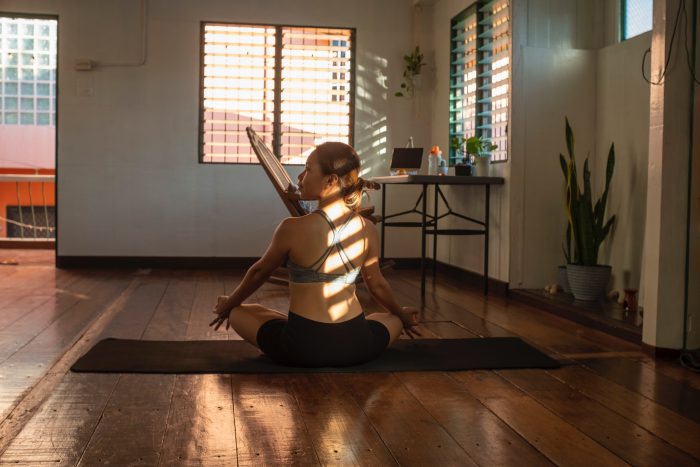The modern yoga market with its vast array of diverse teachings, teachers and styles, is both beautiful and bewildering.
It’s easy to see how beginners could be overwhelmed or intimidated by all the options.
In the interest of brevity and user-friendliness, this glossary is limited to types of hatha yoga. The whole of “yoga” is actually an incredibly vast field that encompasses karma yoga, tantra, meditation practices and much more.
Here’s a quick guide to some of the most popular yoga styles being taught today.
Please note: I’ve selected the styles with which I’m personally the most familiar.
Feel free to add information about additional styles or lineages in the comments section.
1) AcroYoga: a style of partner yoga that involves one person as the base and another person “flying” in various poses balanced on the base’s feet and a third, the spotter. It is a challenging physical practice that blends elements of yoga, acrobatics, performance and healing arts.
2) Ananda: a gentle hatha style that comes from the lineage of Parmahamsa Yogananda, the author of the classic book, Autobiography of a Yogi. The focus is on gentle poses, mantra meditation and sweet relaxation.
3) Anusara: a lineage established in 1997 by American yogi John Friend. It was rocked by a scandal in 2012, which led to Friend stepping down from his leadership role. Anusara style focuses on “attitude, alignment and action.” Some of its principles of alignment include “opening to grace,” inner and outer spirals and various energy loops in the body.
4) Ashtanga: a lineage headed by Indian guru Sri K. Pattabhi Jois, even the first series of this style is extremely physically challenging. It involves a prescribed sequence of sun salutations A and B, followed by standing, balancing, seated, twisting and reclining poses. More advanced Ashtanga practices include bandhas (internal locks) and drishti (focused gaze). Ashtanga is the precursor for most vigorous styles of hatha yoga, including its most commonly taught derivatives, Power Yoga and Vinyasa.
5) Bikram: headed by controversial Indian teacher Bikram Choudhury, it involves a prescribed series of 26 poses, each practiced twice in a row, in a room heated to over 100 degrees Fahrenheit. (Full disclosure: I abhor Bikram yoga and recommend against it.)
6) Dharma: a style of eclectic hatha yoga that incorporates Buddhist philosophies and teachings and a focus on Zen or Tibetan Buddhist techniques of meditation.
7) Forrest: a modern lineage headed by Los Angeles based teacher Ana Forrest. Her style weaves yogic and Native American/Shamanic teachings. Poses are typically held for many breath cycles. Lots of core-strengthening and fierce balancing poses are integral to the Forrest Yoga practice.
8) Hatha: the term “hatha yoga” technically encompasses all of the lineages listed here. However, when you see a class labeled “hatha,” it typically means that each pose is held for several breaths, versus flowing more quickly from one pose to the next. Hatha classes are usually slower paced and more accessible to beginners than vinyasa/flow style classes.
9) Hatha Flow: a hatha flow class will involve some slow to medium-paced flowing from pose to pose, through sun salutations or other series of connected poses—followed by sustaining each of the postures for a longer period. Hatha flow classes vary greatly from teacher to teacher.
10) Hot: hatha and/or vinyasa yoga practiced in a heated room. In this way, it is similar to Bikram yoga, but due to Mr. Choudhury’s copyrights, hot yoga teachers are not legally allowed to use his sequence unless they have gone through the official Bikram teacher training.
11) Iyengar: a lineage headed by Indian guru B.K.S. Iyengar, who has been teaching and training teachers at his center in Pune, India, for decades. The focus is on precise, correct alignment. Yoga props including blocks and straps are often incorporated into the poses to enable practitioners to modify the pose to their level of ability.
12) Jivamukti: a modern lineage founded by NYC power couple David Life and Sharon Gannon. This style involves chanting, sacred music (kirtan) and both hatha flow and sustained hatha poses—as well as an emphasis on meditation and pranayama (breathing exercises).
13) Kids: due to the shorter attention span of young children, a kids’ yoga class may incorporate games and stories and move more quickly from pose to pose.
14) Kundalini: this lineage’s founder is the Indian (Sikh) guru, Yogi Bhajan. Serious Kundalini yoga practitioners wear all white garments, including a turban covering their hair, which they never cut. Kundalini practices—called kriyas—typically involve fast, repetitive motions sustained for several minutes. Breath of fire (quick, forceful exhalations through the nose) is done in many of the poses. There is an emphasis on chanting, chakras and mantra meditation.
15) Mysore: (See also Ashtanga.) Named for the Indian city where Pattabhi Jois taught, it is a self-paced practice done early in the morning. An instructor is there for guidance but does not lead the class as in a normal Ashtanga class.
16) Partner: as you can probably guess, this style involves two people executing poses together. AcroYoga and Thai Yoga Massage are two polar examples of partner yoga.
17) Pilates: this exercise system is not yoga, but it made the list because it is so often combined with yoga or taught at the same location. Its main focus is on strengthening and developing stability in the core abdominal muscles.
18) Power: (See also Ashtanga.) Derivatives of Ashtanga fall under the umbrella of “power yoga.” This vigorous style will inevitably include plenty of fast-paced sun salutations and other intermediate to advanced poses, flowing from one to the next. Be prepared to sweat. Some of the most popular teachers of this style include Baron Baptiste, Bryan Kest and Shiva Rea.
19) Prenatal & Postnatal: gentle hatha yoga modified for pregnant and post-partum women. These practices omit deep backbends, deep twists and poses done lying on the belly, for obvious reasons.
20) Restorative: in this style, the poses are all done lying on the floor in various positions using lots of bolsters, blankets and blocks to enable the practitioner to relax completely and stay in the pose for several minutes.
21) Sivananda: this lineage’s guru is Swami Sivananda, who established many international ashrams in the mid 20th century. Sivananda class begins with a few moderately-paced sun salutations and includes several brief periods of savasana (deep relaxation in corpse pose) interspersed throughout the hatha practice. This lineage also emphasizes yogic philosophy and texts (especially the Bhagavad Gita) as well as chanting, meditation, pranayama and Ayurvedic nutrition.
22) Thai Yoga Massage: this style of partner yoga/massage originated in Thailand. Most of the poses involve one person giving an adjustment to the receiver (who is usually in a reclining position), using his or her hands, elbows and feet. The focus is on energy lines and pressure points as taught in traditional Chinese medicine.
23) Vinyasa: One of the most ubiquitous styles of modern yoga, Vinyasa involves flowing from one pose to the next with fluidity. It is like Ashtanga, only it does not always involve the same sequence of poses in each class. The terms “Vinyasa” and “Vinyasa flow” are interchangeable. These types of classes vary greatly from teacher to teacher.
24) Yin: this style is all about letting go, releasing effort and surrendering muscular tension. It seeks to deepen flexiblity of the fascia, tendons and ligaments as opposed to just the muscles. Most yin poses are performed lying on the floor. Yin poses are held for up to 10 minutes each.
Relephant:
7 Sensational, Classic Yoga Books for Beginners
11 Common Misconceptions about Yoga
Like elephant yoga on Facebook.
Editor: Rachel Nussbaum












Read 44 comments and reply